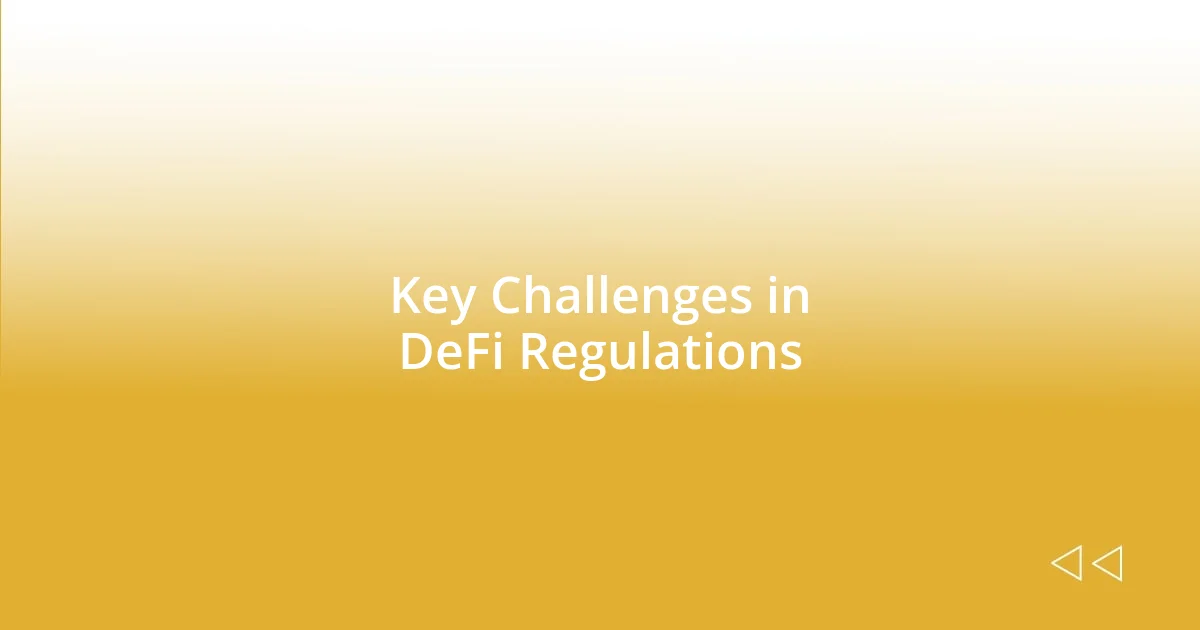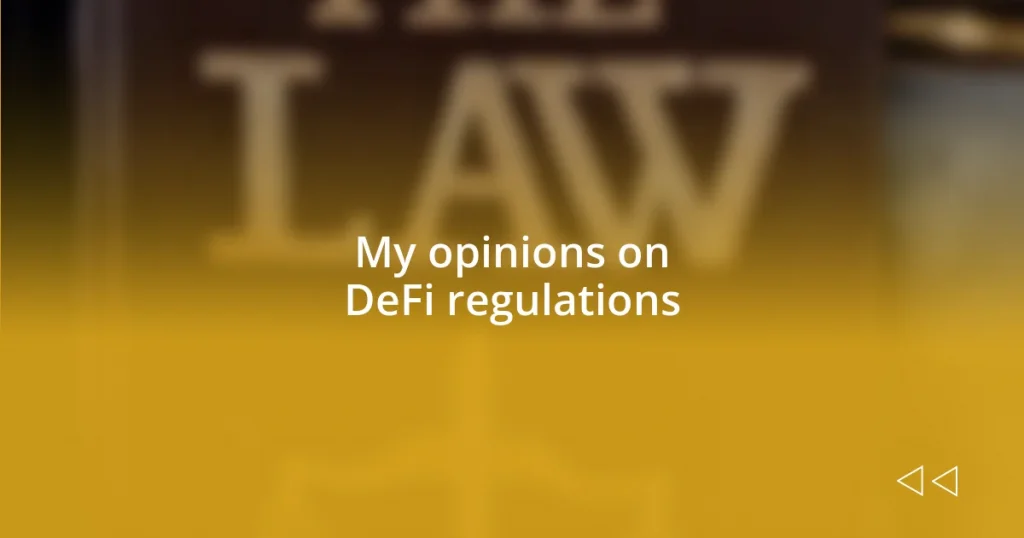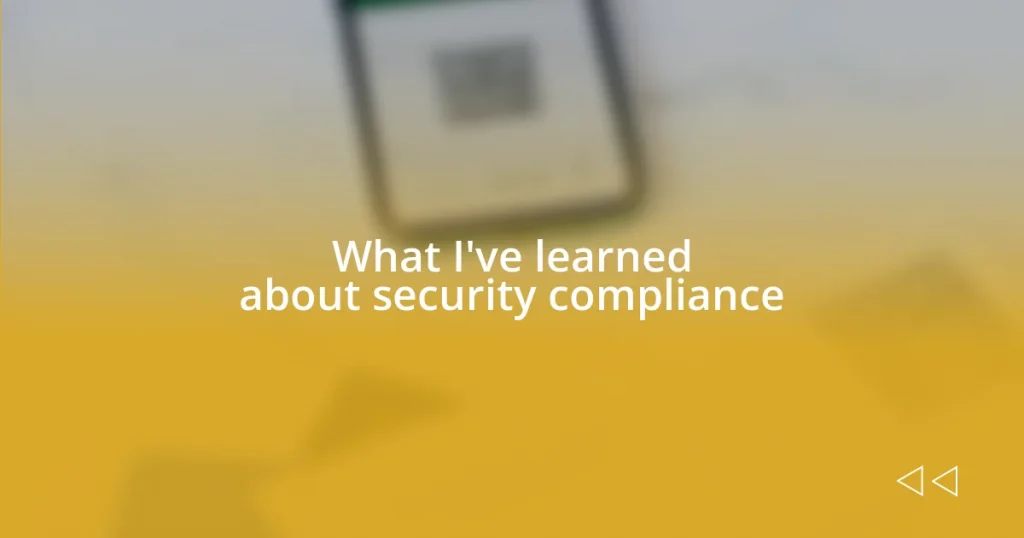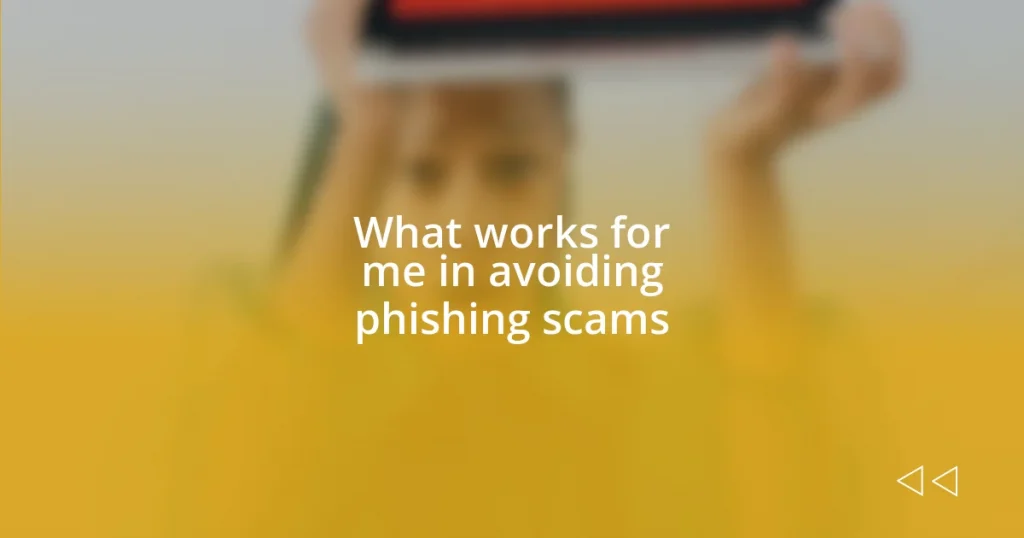Key takeaways:
- DeFi empowers individuals by providing access to financial services without intermediaries, promoting inclusivity and innovation.
- The regulatory landscape for DeFi varies globally, with some jurisdictions fostering innovation (e.g., Singapore) while others impose strict regulations (e.g., China), creating confusion and compliance challenges.
- Future trends in DeFi regulation may include global collaboration, decentralized identity solutions, and regulatory sandboxes, which could enhance innovation while ensuring compliance.

Understanding DeFi and Its Importance
Decentralized Finance, or DeFi, represents a radical shift in how we view money and transactions. Think back to the first time you used your smartphone for banking. Wasn’t it an exhilarating feeling to manage your finances with just a few taps? DeFi captures that same spirit of empowerment, allowing users to directly access financial services without intermediaries, enabling a more inclusive financial ecosystem for everyone.
The important aspect of DeFi is its ability to provide access to financial tools that were once exclusively reserved for the wealthy. I remember meeting a friend from a developing country who struggled to get a loan through traditional banks. After discovering DeFi, they were able to access capital through peer-to-peer lending platforms. It’s empowering to see how DeFi can transform lives, granting individuals the financial independence they deserve.
Moreover, DeFi opens up a new frontier in innovation and collaboration. As I dive deeper into this world, I often wonder: how many groundbreaking financial services will emerge from this space? With its transparent protocols and open-source nature, the potential for creativity is immense. I’ve seen projects that democratize wealth and promote financial literacy taking off faster than I could have imagined, highlighting DeFi’s pivotal role in shaping the future of finance.

Current State of DeFi Regulations
The current state of DeFi regulations is anything but uniform. Different jurisdictions are approaching this burgeoning sector with varying degrees of oversight. For instance, in the United States, regulatory bodies like the SEC have started to signal their intent to enforce existing securities laws on DeFi protocols, which can lead to uncertainty for developers and users alike. I recall my own experience navigating these waters; I remember feeling both excitement and trepidation as I participated in a DeFi project that seemed promising, yet I questioned how long it would remain compliant under potential new regulations.
In contrast, countries like Singapore are taking a more progressive approach, working to create a framework that encourages innovation while providing necessary consumer protections. Their regulatory sandbox allows for experimentation without the immediate burden of compliance. It reminds me of when I first began exploring blockchain technologies; it was liberating to operate within an environment that encouraged growth. Seeing such aims for balance in Singapore gives me hope that regulators can play a constructive role in DeFi’s evolution.
However, even within progressive frameworks, inconsistencies can arise. Various DeFi projects face numerous challenges in terms of legal definition and categorization, leading to a patchwork of compliance requirements globally. Reflecting on my own journey in DeFi, I’ve encountered confusing guidelines that vary not just from country to country, but even from one state to another. This inconsistency can hinder collaboration and deter potential investors, as I personally experienced when trying to explain the benefits of a cross-border DeFi project to skeptics who were unsure about its legality.
| Country | Regulatory Approach |
|---|---|
| United States | Enforcement of existing securities laws; uncertainty for developers |
| Singapore | Encouraging innovation through a regulatory sandbox; striving for balance |
| European Union | Developing MiCA regulations for crypto assets; aiming for consistency |
| China | Broad ban on cryptocurrencies; strict regulation of DeFi projects |

Key Challenges in DeFi Regulations
The landscape of DeFi regulations is fraught with complexities that make it challenging to navigate. One major hurdle is the lack of clarity around the legal status of various tokens and platforms. I remember attending a conference where a panelist discussed how many projects operate in a gray area, not quite fitting into existing regulatory frameworks. It struck me that this uncertainty creates anxiety among developers who’ve poured their hearts into innovative projects, unsure of what the future holds.
- Diverse Regulatory Standards: Different countries have different rules, leading to a fragmented landscape.
- Legal Ambiguities: Unclear definitions for tokens and platforms can lead to confusion and fear of non-compliance.
- Risk Aversion: Many developers hesitate to launch their projects due to potential regulatory backlash.
- Investor Uncertainty: Vague regulations can turn off potential investors, impacting funding and innovation.
Another significant challenge lies in the technology itself. I’ve had conversations with developers who describe the struggle of creating smart contracts that conform to multiple regulatory regimes. The irony is that the very decentralization that makes DeFi appealing also complicates compliance. You build something revolutionary, only to find it may not comply with the very laws meant to protect users. This tug-of-war between innovation and compliance is something that I think about often, especially as I watch promising projects stall due to regulatory issues that seem out of their control.
- Tech and Compliance Gap: Emerging technologies often outpace existing regulations, leading to enforcement challenges.
- Smart Contract Complexity: Developers must build contracts that can potentially adhere to numerous jurisdictional requirements.
- Balancing Act: The challenge lies in fostering innovation while adhering to compliance demands.
- Regulatory Frustration: Developers often feel overwhelmed and discouraged by the influence of regulations on their creative processes.

Impact of Regulations on Innovation
The interplay between regulations and innovation in DeFi is fascinating, yet complex. I’ve witnessed firsthand how rigid regulatory frameworks can stifle creativity. When I was collaborating with a startup aiming to revolutionize lending protocols, we constantly felt the weight of compliance requirements looming over our heads. It made me wonder—can true innovation thrive when developers are shackled to outdated laws?
There’s also an undeniable irony in how regulations can push innovation underground. In a recent conversation with a fellow developer, we lamented about projects that succeed in remaining compliant yet lack the boldness that typically characterizes groundbreaking ideas. It’s like watching a brilliant artist who holds back on their craft because they fear judgment. If regulations continue to focus solely on restriction, will we lose out on the next big breakthrough?
On the flip side, some argue that proper regulations can act as a safety net for genuine innovation. I recall attending a roundtable discussion where industry leaders highlighted how guidelines can create a level playing field, fostering trust among users. It really made me think: could the right regulatory framework actually ignite rather than extinguish the spark of creativity? Balancing innovation with accountability is a tricky endeavor, but perhaps it’s essential for the long-term success of DeFi.

Best Practices for Compliance
Ensuring compliance in the DeFi space starts with establishing a strong understanding of the regulatory environment. I’ve seen how crucial it is for teams to dedicate time to research and stay informed about evolving laws in their jurisdictions. Whenever I speak to developers, I emphasize that being proactive can mitigate risks and enhance the project’s credibility.
Another best practice is to implement rigorous KYC (Know Your Customer) and AML (Anti-Money Laundering) protocols. When I was involved with a DeFi project, we decided to invest in these measures early on. It was enlightening to see how this not only built trust with our users but also attracted investors who valued transparency. After all, a strong compliance framework can be a unique selling point in a crowded market.
Finally, fostering a culture of compliance within the development team can make a significant difference. I’ve observed teams that engage in continuous education about regulatory changes and compliance best practices. It creates a sense of ownership among team members, as they feel directly involved in safeguarding the integrity of their innovations. Shouldn’t every project strive to create an environment where compliance and creativity can coexist?

Future Trends in DeFi Regulation
As I look ahead, I can’t help but feel that the future of DeFi regulation will be shaped by global collaboration among regulators. Just the other day, during a panel discussion, I heard experts emphasize the importance of harmonizing regulations across different jurisdictions. Imagine how powerful it could be if countries worked together to establish a cohesive framework! I believe this could ease the compliance burden that startups often face, allowing them to innovate freely.
I’ve also noticed an increasing focus on decentralized identity solutions as a part of future regulatory trends. I had an enlightening conversation with a friend working on an identity verification project, who pointed out that these technologies could revolutionize how users authenticate themselves while maintaining their privacy. Could embracing decentralized identity be the key to satisfying both regulatory requirements and user autonomy? In my view, this shift could lead to a much-needed balance between compliance and the core principles of decentralization.
Lastly, I suspect we might see a rise in regulatory sandboxes specifically designed for DeFi projects. In my experience, experimenting within a controlled environment has proven to be an effective way for startups to test their ideas without overwhelming legal implications. These sandboxes could serve as a breeding ground for innovation, while still allowing regulators to keep a close watch and adapt their approaches. Isn’t it exciting to think about a future where experimentation and regulation can go hand in hand?

Conclusion and Personal Insights
Navigating the complex landscape of DeFi regulations has been both a challenge and a privilege for me. I often reminisce about my participation in regulatory workshops where the friction between innovation and legislation was palpable, yet inspiring. Do we really have to choose between the two? I believe striking a balance is vital, and I’ve witnessed firsthand how proactive conversations between developers and regulators can foster a healthier ecosystem.
Reflecting on my journey, I’m particularly energized by the potential for education in the DeFi space. I recall a moment when a team I collaborated with held a seminar on compliance awareness, and the engagement level was through the roof. What if every DeFi project adopted a similar approach? By prioritizing education and collaboration, we can cultivate a culture of compliance that empowers both developers and users, rather than stifling creativity.
As we look toward the future, I can’t help but feel hopeful about the evolving landscape of DeFi regulations. It’s thrilling to think about innovations like decentralized identity paving the way for a more secure yet user-friendly framework. Isn’t it time we redefined how we view compliance—not as a barrier, but as a catalyst for trust and creativity? My optimism is rooted in the belief that with the right mindset, we can embrace regulation as a partner in our drive for transformative change.















